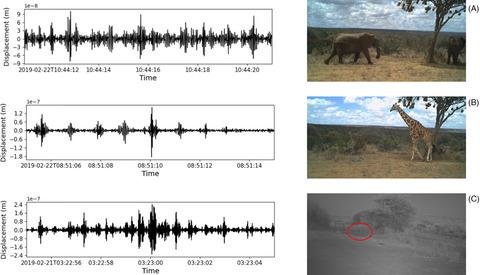当前位置:
X-MOL 学术
›
Remote Sens. Ecol. Conserv.
›
论文详情
Our official English website, www.x-mol.net, welcomes your feedback! (Note: you will need to create a separate account there.)
Seismic savanna: machine learning for classifying wildlife and behaviours using ground-based vibration field recordings
Remote Sensing in Ecology and Conservation ( IF 5.5 ) Pub Date : 2021-11-09 , DOI: 10.1002/rse2.242 Alexandre Szenicer 1 , Michael Reinwald 2 , Ben Moseley 3 , Tarje Nissen‐Meyer 1 , Zachary Mutinda Muteti 4 , Sandy Oduor 4 , Alex McDermott‐Roberts 2 , Atilim G. Baydin 3, 5 , Beth Mortimer 2
Remote Sensing in Ecology and Conservation ( IF 5.5 ) Pub Date : 2021-11-09 , DOI: 10.1002/rse2.242 Alexandre Szenicer 1 , Michael Reinwald 2 , Ben Moseley 3 , Tarje Nissen‐Meyer 1 , Zachary Mutinda Muteti 4 , Sandy Oduor 4 , Alex McDermott‐Roberts 2 , Atilim G. Baydin 3, 5 , Beth Mortimer 2
Affiliation

|
We develop a machine learning approach to detect and discriminate elephants from other species, and to recognise important behaviours such as running and rumbling, based only on seismic data generated by the animals. We demonstrate our approach using data acquired in the Kenyan savanna, consisting of 8000 h seismic recordings and 250 k camera trap pictures. Our classifiers, different convolutional neural networks trained on seismograms and spectrograms, achieved 80%–90% balanced accuracy in detecting elephants up to 100 m away, and over 90% balanced accuracy in recognising running and rumbling behaviours from the seismic data. We release the dataset used in this study: SeisSavanna represents a unique collection of seismic signals with the associated wildlife species and behaviour. Our results suggest that seismic data offer substantial benefits for monitoring wildlife, and we propose to further develop our methods using dense arrays that could result in a seismic shift for wildlife monitoring.
中文翻译:

地震稀树草原:使用地面振动场记录对野生动物和行为进行分类的机器学习
我们开发了一种机器学习方法来检测和区分大象与其他物种,并仅基于动物产生的地震数据识别重要的行为,例如奔跑和隆隆声。我们使用在肯尼亚稀树草原采集的数据展示了我们的方法,其中包括 8000 小时的地震记录和 25 万张相机陷阱图片。我们的分类器是在地震图和频谱图上训练的不同卷积神经网络,在检测 100 m 以外的大象方面实现了 80% 到 90% 的平衡精度,在从地震数据中识别奔跑和隆隆声行为方面达到了 90% 以上的平衡精度。我们发布了本研究中使用的数据集:SeisSavanna 代表了具有相关野生动物物种和行为的独特地震信号集合。
更新日期:2021-11-09
中文翻译:

地震稀树草原:使用地面振动场记录对野生动物和行为进行分类的机器学习
我们开发了一种机器学习方法来检测和区分大象与其他物种,并仅基于动物产生的地震数据识别重要的行为,例如奔跑和隆隆声。我们使用在肯尼亚稀树草原采集的数据展示了我们的方法,其中包括 8000 小时的地震记录和 25 万张相机陷阱图片。我们的分类器是在地震图和频谱图上训练的不同卷积神经网络,在检测 100 m 以外的大象方面实现了 80% 到 90% 的平衡精度,在从地震数据中识别奔跑和隆隆声行为方面达到了 90% 以上的平衡精度。我们发布了本研究中使用的数据集:SeisSavanna 代表了具有相关野生动物物种和行为的独特地震信号集合。



























 京公网安备 11010802027423号
京公网安备 11010802027423号